The History Of Renault Laguna

The Renault Laguna is a large family car produced by the French manufacturer Renault. The first Laguna was launched in 1993, the second generation was launched in 2000, and the third generation was made available for sale in October 2007.
The first generation Renault Laguna was launched in December 1993 as replacement for the Renault 21, initially coming as a hatchback only. Late in 1995 it was introduced an estate version, known in some markets as the Laguna Sport Tourer, and replaced the 21-based Renault Savanna/ Nevada.
The Laguna's equipment levels were gradually getting more lavish, and soon all models came with power steering, electric front windows, driver's airbag and remote central locking as standard. Most of the range had twin airbags, anti-lock braking system, air-conditioning and CD player as either optional or standard equipment.
Laguna I b
At the start of 1998 the Laguna received a moderate facelift, including a restyling of the hatchback of the Sport Tourer version, and a redesigned front. This included different design of the lights, most noticeable are the circular fog-lights in the front.
More notably, the engines were updated and, in some markets, equipment levels enhanced again. Five new engines featured in the completed facelifted line-up:
- 1.6 16v
- 1.8 16v
- 1.9 dTi (turbo-charged direct injection)
- 1.9 dCi (common-rail injection, turbo)
- 2.2 dTi (turbo-charged direct injection)
The dTi versions were direct injection diesels, and replaced the old 2.2D and 2.2TD versions that were available prior to 1998.
2000 saw the final edition of this Laguna - the Laguna Concorde. It had many extras, including semi-leather seats and vocal warnings like "Welcome. The vehicle computer... is now checking systems for you". The on-board computer was highly intelligent and would notify the driver of any doors not being closed, lights left on etc, or other serious fault in the vehicles entire electrical/ mechanical circuit. It is a common complaint that on 1993-2000(Mk.1) Laguna's the rear wheel bearings wear out and begin to 'hum' at approximately 45,000mi (72,000km)-55,000mi (89,000km) and require renewal shortly afterwards.[citation needed] The Laguna "Concorde" model was the last guise of the 'old' Laguna's to be marketed prior to the release of the Laguna II in 2001, the last of the Mk.1 Laguna's were registered in February 2001 and the Concorde range all feature a cream letter "C" on a dark green background, with the outline of a Concorde aircraft above the letter.
At the end of 2000, after almost seven years of production, the original Laguna was replaced by an all-new model which shared its chassis with the Nissan Primera (which arrived a year later). The engines were upgraded and the equipment list made longer. Widely regarded as one of the safest vehicles on the road today, it was the first vehicle available in Europe to achieve 5 stars in the EuroNCAP crash test results, a feat which was soon followed by all other models in Renault UK's current model line-up. The Laguna featured a 'keyless' ignition system which, instead of a key, used a credit card style device to unlock the car and start the engine. The styling of the second generation Laguna was heavily influenced by the Initiale concept car.
The Laguna estate was only available with five seats, unlike the previous model which has seven seats as an option on some versions. It was badged Sport Tourer or Grandtour depending on the country, and was marketed as a lifestyle vehicle rather than a load carrier.
Laguna II b
The Laguna II had relaunch in March 2005, according to Renault with improved security, driving performance and comfort. It also had a moderate redesign of the air intake at the front of the car, now matching the design of the Megane. A electronic handbrake was also introduced, this was previously seen on the Scenic and Espace The engines were much the same as before, with the 1.6 and 1.8 petrol units being offered in some markets, while other countries get a 2.0 petrol unit (turbo or non-turbo) and two diesels (1.9 or 2.2 direct-injection). After facelift Laguna comes with the third and whole new diesel engine 2.0 dCi with 150hp (112kW) and 175hp (130kW),this one the most powerful 2 litre diesel engine in the world as of May 2007.
Engines
- 1.6 L (1598 cc) 16-valve I4; 110bhp (82kW; 112PS); top speed: 195km/ h (121mph); 0-100km/ h; 11.5 s 2001-2005
- 1.6 L (1598 cc) 16-valve I4; 115bhp (86kW; 117PS); top speed: 197km/ h (122mph); 0-100km/ h; 11.5 s 2005-2007
- 1.8 L (1783 cc) 16-valve I4; 123bhp (92kW; 125PS); top speed: 201km/ h (125mph); 0-100km/ h; 10.8 s 2001-2005
- 2.0 L (1998 cc) 16-valve I4; 135bhp (101kW; 137PS); top speed: 205km/ h (127mph); 0-100km/ h; 9.9 s 2002-2005
- 2.0 L (1998 cc) 16-valve I4; 135bhp (101kW; 137PS); top speed: 207km/ h (129mph); 0-100km/ h; 9.8 s 2005-2007
- 2.0 L (1998 cc) 16-valve IDE I4; 140bhp (104kW; 142PS); top speed: 210km/ h; 0-100km/ h; 9.8 s 2001-2003
- 2.0 L (1998 cc) 16-valve T I4; 163bhp (122kW; 165PS); top speed: 218km/ h (135mph); 0-100km/ h; 8.5 s 2003-2005
- 2.0 L (1998 cc) 16-valve T I4; 170bhp (127kW; 172PS); top speed: 223km/ h (139mph); 0-100km/ h; 8.4 s 2005-2007
- 2.0 L (1998 cc) 16-valve T I4; 205bhp (153kW; 208PS); top speed: 235km/ h (146mph); 0-100km/ h; 7.2 s 2005-2007
- 3.0 L (2946 cc) 24-valve V6; 210bhp (157kW; 213PS); top speed: 235km/ h (146mph); 0-100km/ h; 8.1 s 2001-2005
- 3.0 L (2946 cc) 24-valve V6; 210bhp (157kW; 213PS); top speed: 235km/ h (146mph); 0-100km/ h; 8.0 s 2005-2007
- 1.9 L (1870 cc) 8-valve dCi I4; 92bhp (69kW; 93PS); top speed: 183km/ h (114mph); 0-100km/ h; 14.2 s 2004-2005
- 1.9 L (1870 cc) 8-valve dCi I4; 92bhp (69kW; 93PS); top speed: 182km/ h (113mph); 0-100km/ h; 13.6 s 2005-2006
- 1.9 L (1870 cc) 8-valve dCi I4; 101bhp (75kW; 102PS); top speed: 185km/ h (115mph); 0-100km/ h; 13.0 s 2001-2005
- 1.9 L (1870 cc) 16-valve dCi I4; 110bhp (82kW; 112PS); top speed: 194km/ h (121mph); 0-100km/ h; 12.3 s 2005-2005
- 1.9 L (1870 cc) 16-valve dCi I4; 110bhp (82kW; 112PS); top speed: 194km/ h (121mph); 0-100km/ h; 12.1 s 2005-2007
- 1.9 L (1870 cc) 8-valve dCi I4; 120bhp (89kW; 122PS); top speed: 200km/ h (124mph); 0-100km/ h; 10.7 s 2001-2005
- 1.9 L (1870 cc) 8-valve dCi I4; 120bhp (89kW; 122PS); top speed: 202km/ h (126mph); 0-100km/ h; 10.7 s 2005-2007
- 1.9 L (1870 cc) 16-valve dCi I4; 130bhp (97kW; 132PS); top speed: 204km/ h (127mph); 0-100km/ h; 10.2 s 2005-2007
- 2.0 L (1995 cc) 16-valve dCi I4; 150bhp (112kW; 152PS); top speed: 215km/ h (134mph); 0-100km/ h; 8.9 s 2005-2007
- 2.0 L (1995 cc) 16-valve dCi I4; 175bhp (130kW; 177PS); top speed: 225km/ h (140mph); 0-100km/ h; 8.4 s 2005-2007
- 2.2 L (2188 cc) 16-valve dCi I4; 150bhp (112kW; 152PS); top speed: 215km/ h (134mph); 0-100km/ h; 9.8 s 2002-2005
The Renault Laguna III was officially announced in a press release on June 4, 2007. The car was unveiled to the public at the Frankfurt Motor Show in September, and it went on sale in October 2007. The car comes as a 5-door liftback, as a 5-door estate and a 3 door coupe now. This third generation is based on the platform D, shared with the Nissan Altima and the Nissan Murano.
The Laguna III is the first car to have gone through Aubevoye Technical Centre's Electro-Magnetic Compatibility unit in the course of its development.
For this third generation, a coupé version was also developed, to compete with the Peugeot 407 Coupé. It was first presented as a concept car at the 2007 Frankfurt Motor Show, which followed some styling cues of the previous Renault Fluence concept car. The production version was revealed at the 2008 Cannes Film Festival, coinciding with the Monaco Formula 1 Grand Prix to take the wraps off. The brand new V6 dCi engine delivers 235hp (173kW), while the new 3.5-litre petrol powered V6 offers 240hp (175kW). The Laguna Coupé later appeared before the general public at the Paris Motor Show in October 2008.
In January 2008, spy images of a possible Laguna Sedan appeared on the internet . It was rumoured that it would be revealed at the Paris Motor Show alongside the Coupé, but that did not happen. It is now thought that it may appear at the 2009 Geneva Motor Show.
Engines
- 1.6 L (1598 cc) 16-valve I4; 110 bhp (79 kW); top speed: 192km/ h (119mph); 0-100km/ h; 11.7 s 2007-
- 2.0 L (1997 cc) 16-valve I4; 140 bhp (103 kW); top speed: 210km/ h (130mph); 0-100km/ h; 9.1 s 2007-
- 2.0 L (1998 cc) 16-valve Turbo I4; 170 bhp (125 kW); top speed: 220km/ h (137mph); 0-100km/ h; 9.2 s 2007-
- 2.0 L (1998 cc) 16-valve Turbo I4; 205 bhp (150 kW); top speed: 232km/ h (144mph); 0-100km/ h; 7.8 s 2008-
- 1.5 L (1461 cc) 8-valve dCi I4; 110 bhp (81 kW); top speed: 192km/ h (119mph); 0-100km/ h; 12.1 s 2007-
- 2.0 L (1995 cc) 16-valve dCi I4; 130 bhp (96 kW); top speed: 204km/ h (127mph); 0-100km/ h; 10.6 s 2007-
- 2.0 L (1995 cc) 16-valve dCi I4; 150 bhp (110 kW); top speed: 210km/ h (130mph); 0-100km/ h; 9.5 s 2007-
- 2.0 L (1995 cc) 16-valve dCi I4; 175 bhp (127 kW); top speed: 220km/ h (137mph); 0-100km/ h; 8.7 s 2007-
- 2.0 L (1995 cc) 16-valve dCi I4; 180 bhp (131 kW); top speed: 222km/ h (138mph); 0-100km/ h; 8.5 s 2008-
- 4WS (Four Wheel Steering) Called Active Drive introduced by Renault for 2008 uses a rear steering actuator similar to the HICAS system used in several Nissan and Infiniti models, which allows better cornering dynamics, high speed stability and decreased turning radius.
- 1994, January - Laguna hatchback launched, with 1.8 8V, 2.0 8V and PRV V6 engine options.
- 1994, October - Normally aspirated 2.2 litre diesel engine added to range.
- 1995 - Sport Tourer launched, and 2.0 litre 16V Volvo engine added to range.
- 1996 - 2.2 litre turbodiesel engine added to range.
- 1997 - V6 engine replaced with new model.
- 1998 - Laguna is revamped, with some small exterior changes (including new front and rear lights) as well as new 1.6 16V and 1.8 16V petrol and 1.9 dTi turbodiesel engines. These units replace the existing 1.8 8V, 2.0 8V and 2.2 normally aspirated diesel engines (the 1.8 8V remains in use for the autogas LPG model, however). The automatic transmission is replaced by the all new "Proactive" transmission, developed and built in collaboration with PSA Peugeot Citroën.
- 1999 - 2.0 litre 16V Volvo engine replaced with new 2.0 litre 16V unit, and 2.2 turbodiesel is replaced by new 1.9 dCi.
- 2000 - The Laguna is replaced with the all-new Laguna II. Engine range entirely upgraded.
- 2005 - Laguna II revamped. Minor cosmetic changes in and out, engines vary according to country, with 1.6 or 1.8 petrol units offered along with a 2.0 petrol unit (turbo or non-turbo) and two diesels (1.9 or 2.2 direct-injection). New Renault-Nissan 2.0 dCi engine replaced the 2.2 dCi from late 2005, providing 150bhp (112kW; 152PS) or 175bhp (130kW; 177PS) . 120bhp (89kW; 122PS) Euro III 1.9 dCi phased out in favour of 130bhp (97kW; 132PS) Euro IV 1.9 dCi FAP. The 2.2dCi is retained in FAP form for automatic transmission models only as a 140bhp (104kW; 142PS) engine. In both cases, Euro IV compliance is achieved using a Diesel particulate filter.
- 2007, June - The Laguna III is officially announced, and scheduled for sale in October as 5-door hatchback and 5-door sport tourer.
- 2008 - A Coupe added to the current Laguna III range. Adding two new V6 engines which could also possibly be introduced into the rest of the range.
From Wikipedia, the free encyclopedia
More About Renault Laguna
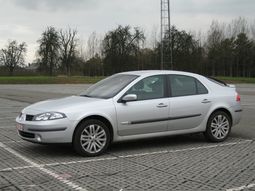
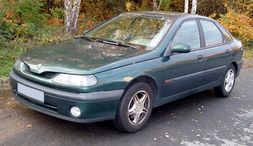
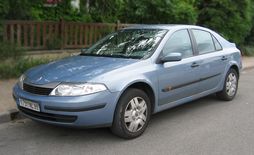
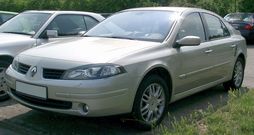
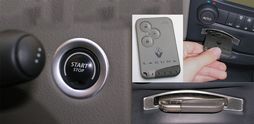
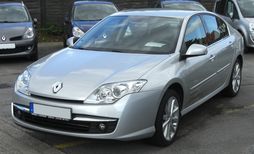
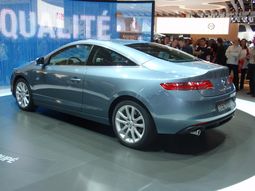
|